|
| |
4th Seminar of 70mm film in Krnov 2009
3. - 5. April 2009, Kino Mir 70, Krnov, The Czech Republic
|
Read more
at
in70mm.com
The 70mm Newsletter
|
|
Written
by: Jakub Klíma |
Date:
04.03.2009 |
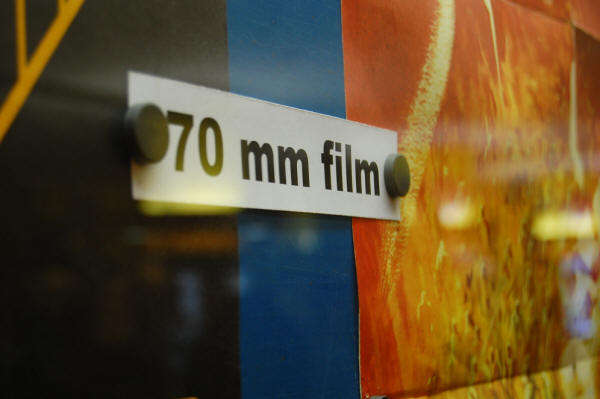 4th Seminar of 70mm film in Krnov
3 - 5 . April 2009. 4th Seminar of 70mm film in Krnov
3 - 5 . April 2009.
Under patronage of the Municipal centre of information and culture Krnov,
together with Ministry of Culture, under the patronage of town
major of Krnov, the Mir 70 theatre will again
be the meeting point for film enthusiasts from not only the Czech Republic but also visitors
from many European counties, including Austria, Holland, France, Poland and Germany.
In 2009, we are remembering 40th anniversary of first 70mm
screening in Mír 70 theather. The first 70mm feature film shown
to Krnov's audience was "Those Magnificient Men in Their
Flying Machines", therefore this titel can not be left out
from this year programm. Another film which is enjoying it's
anniversary is Alien which has been released 30 years ago. Among
these titels we are proud to announce screenings of "2001:
Space Odyssey" and "The Last Valley" (theatrical
premiere). As a sneak-preview we managed to bring to our
audience new french film "Faubourg 36".
Apart the film excitement every festival visitor can enjoy small
exhibition of screening technique in Mir theather foyer, film
posters are to be on display and lots of interesting comments to
every film. All the visitor will have the opportunity to see
„the behind the scene“ of every projection room and to see the
technology at work (Meopta UM 70/35 projectors).
Should you have any further inquiries, feel free to contac us at
our website.
You can also proceed on-line accreditation
here, or via my
e-mail address:
Should you have any questions, please feel free to contact us.
Jakub Klíma
70mm Festival Organizer
|
More
in 70mm reading:
• Home of "7OMM Seminar" at Kino Mir 70, Krnov, Czech
Republic
7OMM Seminar Through the Years:
• Film Program
• Text and Image
About Todd-AO
• Počátky
Todd-AO
Internet
Kino Mir 70
Namesti Miru 14
794 01 Krnov
The Czech
Republic
Telephone: +420 554 615 050
• Festival Page
•
KRRR! Facebook
|
Weekend 7OMM Program
& Tickets
|
|
Friday, 3. April
14:30 - Signale – Ein Weltraumabenteuer (88 min. + introduction ) 70 mm
6-track magnetic
16:45 - Hauptmann Florian von der Mühle (132 min. + introduction +
intermission ) 70 mm 6-track magnetic
19:45 - Those Magnificent Men in Their Flying Machines, or How I Flew
from London to Paris in 25 hours 11 minutes (138 min. + introduction +
intermission ) 70 mm DTS
22:15 „Get Together“ ( to 40th anniversary 70mm screening in Mir 70
thearther )
Saturday, 4. April
10:00 - Goya (136 min. + introduction + intermission ) 70 mm 6-track
magnetic
13:00 – Baraka (96 min. + intermission ) 70 mm 6-track Dolby A
15:00 – Faubourg (120 min. + introduction ) 70 mm film DTS
18:00 – 2001: Space Odyssey (149 min. + introduction + intermission)
70mm 6 track Dolby SR
21:15 - Alien (117 min. + introduction ) 70 mm 6-track Dolby A
23:30 – The Untouchables (119 min. + introduction ) 70 mm 6-track Dolby
A
Sunday, 5. April
10:00 The Last Valley (125 min. + introduction + intermission ) 70 mm
6-track magnetic
12:45 Terminator 2: Judgment Day (145min + introduction ) 70 mm 6-track
magnetic Dolby A
15:45 - Those Magnificent Men in Their Flying Machines, or How I Flew
from London to Paris in 25 hours 11 minutes (138 min. + introduction +
intermission ) 70 mm DTS
18:45 – 2001: Space Odyssey (149 min. + introduction + intermission)
70mm 6 track Dolby SR
Includes admission to
all screenings during the three days. It does not include accommodation.
Festival Pass Price: 550 CZK/ approx. 20 EUR (it may change due exchange
rate).
Reservation will be accepted by Jakub Klíma
|
|
Weekend 7OMM Program.
Film Info
|
|
Friday, 3. April 2009
|
Signale
|
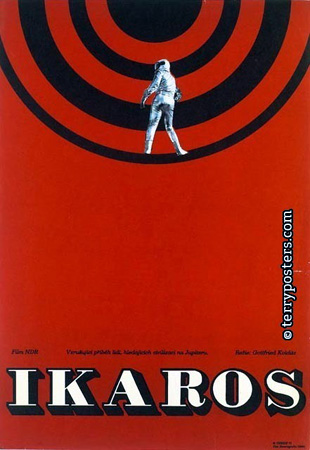  “Signale
- Ein Weltraumabenteuer” (1:28). Filmed in: 70mm, 5
perforations, 24 frames per second. Principal photography in:
DEFA 70. Presented in
the original 70mm German version on the curved screen. Aspect ratio:
2,21:1. Country of origin:
DDR. Production year: 1970. World Premiere:
17.12.1970 Kosmos, East Berlin, DDR.
Czeck premiere: 1.10.1971. Kino Mir 70
premiere: 11.2.1972 “Signale
- Ein Weltraumabenteuer” (1:28). Filmed in: 70mm, 5
perforations, 24 frames per second. Principal photography in:
DEFA 70. Presented in
the original 70mm German version on the curved screen. Aspect ratio:
2,21:1. Country of origin:
DDR. Production year: 1970. World Premiere:
17.12.1970 Kosmos, East Berlin, DDR.
Czeck premiere: 1.10.1971. Kino Mir 70
premiere: 11.2.1972
Directed by: Gottfried Kolditz. Written by: Gottfried Kolditz &
C.U. Wiesner. Original Music by: Karl-Ernst Sasse.
Cinematography by Otto Hanisch. Film Editing by: Helga Gentz
Piotr Pawlowski (Veikko), Ewgeni Sharikow (Pawel), Gojko Mitic
(Terry), Alfred Müller (Konrad), Helmut Schreiber (Gaston)
Looking
for DEFA 70
|
"Hauptmann Florian von der Mühle"
|
  “Hauptmann Florian von der Mühle” (2:20)
+ Intermission after reel 4. Filmed in: 70mm, 5
perforations, 24 frames per second. Principal photography in:
DEFA 70. Presented in
the original 70mm German version with Czeck subtitles on the curved screen. Aspect ratio:
2,21:1. Country of origin:
DDR. Production year: 1968. World Premiere:
22.11.1968 Kino International, East Berlin, DDR.
Czeck premiere: 3.8.1970. Kino Mir 70 premiere:
21.8.1970 “Hauptmann Florian von der Mühle” (2:20)
+ Intermission after reel 4. Filmed in: 70mm, 5
perforations, 24 frames per second. Principal photography in:
DEFA 70. Presented in
the original 70mm German version with Czeck subtitles on the curved screen. Aspect ratio:
2,21:1. Country of origin:
DDR. Production year: 1968. World Premiere:
22.11.1968 Kino International, East Berlin, DDR.
Czeck premiere: 3.8.1970. Kino Mir 70 premiere:
21.8.1970
Directed by Werner W. Wallroth. Music by Karl-Ernst Sasse.
Cinematography by Eberhard Borkmann and Hans-Jürgen Kruse
Manfred Krug (Hauptmann Florian),
Hartmut Beer (Geheimpolizist zu Pferde), Regina Beyer (Duchessa),
Herwart Grosse (Friedrich II.), Rolf Herricht (Amadeus), Jutta
Klöppel (Fanny), Herbert Köfer (Der Medicus)
German version
From DEFA
Film Library:
This story of the miller Florian, who gave all his money to the
war against Napoleon, is loosely based on a true story. After
the war, Florian's reimbursement is challenged, and he must also
pay taxes on his destroyed mill. He resists the tax collectors
and takes off to Vienna, where he intends to defend his rights.
On the way, he rescues the Duchess of Guastalla from assault.
She also wants to go to Vienna, as His Majesty Franz II is
trying to contest an heir in her favor. With cunning, luck, and
dagger, Florian fights his way through a slew of nobility and
their secret police. In the end, he acquires multiple titles,
and the Duchess acquires him.
70mm print thanks to
Kino Mir 70 cinema, Krnov, Czech Republic
DEFA 70
films and
Looking for DEFA 70
|
|
"Those Magnificient Men in Their Flying Machines"
|
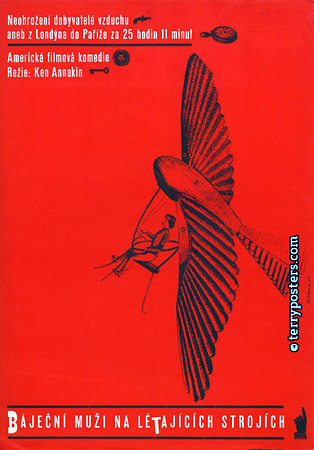  “Those
Magnificient Men in Their Flying Machines, or How I flew from
London to Paris, in 25 hours and 11 minutes”
(2:18) + intermission.
Filmed in:
65mm, 24 frames per second.
Principal photography in: Todd-AO. Presented on:
The curved screen in Todd-AO with 6-track DTS Stereo.
Aspect ratio: 2,21;1. Country of origin: USA. Production year:
1965.
World Premiere: 03.06.1965 Astoria, London, England. Czeck
premiere: 8.9.1967. Kino Mir 70 premiere:
23.5.1969 “Those
Magnificient Men in Their Flying Machines, or How I flew from
London to Paris, in 25 hours and 11 minutes”
(2:18) + intermission.
Filmed in:
65mm, 24 frames per second.
Principal photography in: Todd-AO. Presented on:
The curved screen in Todd-AO with 6-track DTS Stereo.
Aspect ratio: 2,21;1. Country of origin: USA. Production year:
1965.
World Premiere: 03.06.1965 Astoria, London, England. Czeck
premiere: 8.9.1967. Kino Mir 70 premiere:
23.5.1969
40th anniversary screening
allmovie.com:
Ken Annakin's large-canvas comedy "Those Magnificent Men in
Their Flying Machines" is set in 1910. In order to boost
circulation of his newspaper, Lord Rawnsley (Robert Morley)
offers 10,000 pounds to the first person who can fly across the
English Channel. A huge number of hopefuls enter the contest,
including the scheming Sir Percy Ware-Armitage (Terry-Thomas),
who, with the help of his henchman Courtney (Eric Sykes),
attempts to sabotage the other entries. There is also a love
triangle featuring Orvil Newton (Stuart Whitman) and Richard
Mays (James Fox) competing for the heart of Patricia Rawnsley
(Sarah Miles).
What is Todd-AO?
"TODD-AO 70mm film, plus the TODD-AO special camera, plus the
TODD-AO newly developed 6 channel high fidelity magnetic sound,
plus the TODD-AO "all purpose" 70mm projector and the great
arched TODD-AO screen equal the most revolutionary of all screen
inventions, with clarity of perspective, detail and color
reproduction never before achieved. As a result, with TODD-AO,
audience participation now has its fullest and truest
expression. Todd-AO is the dream of Michael Todd, plus the
technical skills of the American Optical Company whose research
staff headed by Dr. Brian O'Brien, jointly succeeded in
developing "a motion picture system that would photograph action
in a very wide angle....with one camera....on one strip of
film....to be projected from a single projector....on a very
wide screen....with a quality so perfect that the audience would
be part of the action, not just passive spectators.
|
Saturday, 4. April 2009
|
"Goya"
|
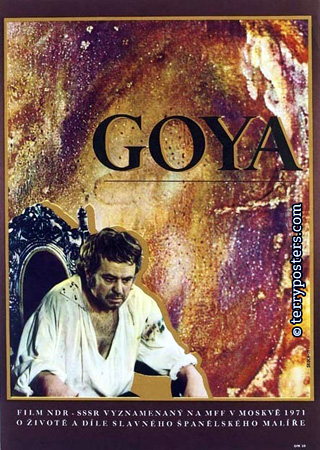  "Goya
– oder der arge Weg der Erkenntnis" / "Goya – or the hard way to enlightment"
(3:26).
Filmed in: 70mm 5 perforations, 24 frames per second.
Principal photography in: DEFA 70. Presented on:
The curved screen in DEFA 70 with 6-track magnetic stereo.
Aspect ratio: 2,21:1. Country of origin: DDR. Production year: 1970.
World Premiere:
16.09.1971,
Kosmos, Berlin, DDR.
Czeck premiere: 20.4.1973. Kino Mir 70
premiere: 9.11.1973. "Goya
– oder der arge Weg der Erkenntnis" / "Goya – or the hard way to enlightment"
(3:26).
Filmed in: 70mm 5 perforations, 24 frames per second.
Principal photography in: DEFA 70. Presented on:
The curved screen in DEFA 70 with 6-track magnetic stereo.
Aspect ratio: 2,21:1. Country of origin: DDR. Production year: 1970.
World Premiere:
16.09.1971,
Kosmos, Berlin, DDR.
Czeck premiere: 20.4.1973. Kino Mir 70
premiere: 9.11.1973.
Directed by Konrad Wolf. Director of Photography: W. Bergmann,
K. Ryshow. Cinematography: Werner Bergmann, Konstantin Ryschow.
Music: Kara and Faradsh Karajew. Set Design: Alfred Hischmeier,
Waleri Jurkewitsch. Costume Design: Ludmilla Schildknecht,
Joachim Dittrich. Dramaturge: Walter Janka, Alexander Dymschitz.
Screenplay: Angel Wagenstein. DEFA 1971
Donatas Banionis (Goya), Olivera Vugo (Duchess Alba), Fred Düren
(Esteve), Tatjana Lolowa (Queen Maria Luisa), Rolf Hoppe (King
Carlos IV), Ernst Busch (Jovellanos), Carmen Herold (Maria
Rosario)
DEFA 70
movies
By Ingolf Vonau,
Berlin, Germany
Certainly the most important and artistic significant 70mm
Feature Film Production of DEFA
Don Francisco de Goya Lucientes (1746 - 1828) is an artist to
the court of Karl IV of Spain. He is well known and well-to-do,
but feels himself becoming more and more remote from the daily
life and suffering of the Spanish people. After meeting the
singer Maria Rosario in a Madrid tavern, where she is singing
revolutionary songs, he becomes even more reflective. Rosario is
hauled before the Inquisition. Goya is invited to attend as a
warning not to stray from the official path. But it doesn't stop
him from increasingly leaving the castle to portray the desires
and nightmares of simple people in his paintings. Soon the
Inquisition is on his trail…
Based on Lion Feuchtwanger's novel "This is the hour – Goya",
and starring the Lithuanian actor Donatas Banionis as main
character, the director Konrad Wolf creates an unconventional
adaptation with images of lasting impressions. Declared aim of
that big DEFA co production with the Russian LENFILM was to
portrait the character of the artist Goya and to show his
painful process of enlightenment in realizing the true Spanish
society. How closely can an artist align himself with the powers
that be if he wants to be honest and creative?
A destiny of an artist as allegory to present. The film was
supposed to be different to the western style of biographical
illustrative screen adaptations in using the cinematographic
tools. Director of Photography Werner Bergmann and his Russian
Colleague Konstantin Ryshow were trying to bring to appear their
special view on how to use wide-screen photography in
filmmaking. According to their principle that only the task not
the possibility demands the format. A point of view sometimes
contrary to the western view of cinematography. At premier night
the 2 part film had a length of 161 min. Some months later the
director himself changed the montage and shortened the film to
134 min. It was his own decision to make the intention in
portraying the painter Goya more understandable. This last
version is the only available one.
Festivals and Awards:
• Moscow International Film Festival, Special Jury Award, 1971
|
"Baraka"
|
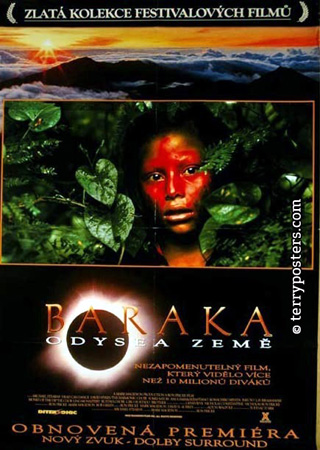  "Baraka"
(1:36).
Filmed in: 65mm 5 perforations, 24 frames per second.
Principal photography in: Todd-AO 70mm. Presented:
on the curved screen in Todd-AO with 6-track magnetic stereo.
Aspect ratio: 2,21:1. Country of origin: USA. Production year: 1992.
World Premiere: 30.08.1992, Montreal World Film Festival. Montreal,
Canada.
Czeck premiere: 15.4.1994. Kino Mir 70
premiere: 6.6.1995 "Baraka"
(1:36).
Filmed in: 65mm 5 perforations, 24 frames per second.
Principal photography in: Todd-AO 70mm. Presented:
on the curved screen in Todd-AO with 6-track magnetic stereo.
Aspect ratio: 2,21:1. Country of origin: USA. Production year: 1992.
World Premiere: 30.08.1992, Montreal World Film Festival. Montreal,
Canada.
Czeck premiere: 15.4.1994. Kino Mir 70
premiere: 6.6.1995
Directed by Ron Fricke. Written by: Constantine Nicholas & Genevieve
Nicholas. Produced by Mark Magidson & Alton Walpole. Music by Michael
Stearns. Cinematography by Ron Fricke. Edited by David Aubrey, Ron
Fricke, Mark Magidson
 Ron Fricke's next film
"Samsara" -
a work in progress Ron Fricke's next film
"Samsara" -
a work in progress
allmovie.com:
Named after a Sufi word that translates roughly
as "breath of life" or "blessing," "Baraka" is Ron
Fricke's impressive follow-up to Godfrey Reggio's non-verbal
documentary film "Koyaanisqatsi". Fricke was
cinematographer and collaborator on Reggio's film, and for
"Baraka" he struck out on his own to polish and expand the
photographic techniques used on "Koyaanisqatsi". The
result is a tour-de-force in 70mm: a cinematic "guided
meditation" (Fricke's own description) shot in 24 countries on
six continents over a 14-month period that unites religious
ritual, the phenomena of nature, and man's own destructive
powers into a web of moving images. Fricke's camera ranges, in
meditative slow motion or bewildering time-lapse, over the
Church of the Holy Sepulcher in Jerusalem, the Ryoan-Ji temple
in Kyoto, Lake Natron in Tanzania, burning oil fields in Kuwait,
the smoldering precipice of an active volcano, a busy subway
terminal, tribal celebrations of the Masai in Kenya, chanting
monks in the Dip Tse Chok Ling monastery...and on and on,
through locales across the globe. To execute the film's
time-lapse sequences, Fricke had a special camera built that
combined time-lapse photography with perfectly controlled
movements of the camera. In one evening sequence a desert sky
turns black, and the stars roll by, as the camera moves slowly
forward under the trees. The feeling is like that of viewing the
universe through a powerful telescope: that we are indeed on a
tiny orb hurtling through a star-filled void. The film is
complemented by the hybrid world-music of Michael Stearns.
|
"Faubourg 36"
|
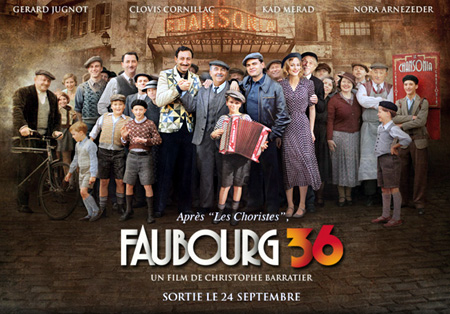 15.00 – 17.00 "Faubourg 36"
Filmed in:
35mm, 4 perforations, 24 frames per second.
Principal photography in: ______. Presented on:
The flat screen in a new 70mm print with 6-track DTS
stereo.
Aspect ratio: 2,21:1. Country of origin: France. Production year:
2008
World Premiere: Gaumont Opera cinema, 24.09.2008, France. Also screened at the Toronto Film Festival, Canada 6 September 2008. 15.00 – 17.00 "Faubourg 36"
Filmed in:
35mm, 4 perforations, 24 frames per second.
Principal photography in: ______. Presented on:
The flat screen in a new 70mm print with 6-track DTS
stereo.
Aspect ratio: 2,21:1. Country of origin: France. Production year:
2008
World Premiere: Gaumont Opera cinema, 24.09.2008, France. Also screened at the Toronto Film Festival, Canada 6 September 2008.
Director: Christophe Barratier. Writer: Christophe Barratier (writer)
Pierre Philippe (dialogue). Produced by: Original Music by Reinhardt Wagner. Cinematography by Tom Stern (director of photography). Film Editing by Yves Deschamps. Production Design by Jean Rabasse
Gérard Jugnot (Pigoil), Clovis Cornillac (Milou). Kad Merad (Jacky Nora Arnezeder (Douce). Pierre Richard (Monsieur TSF), Bernard-Pierre Donnadieu (Galapiat), Maxence Perrin (Jojo), François Morel (Célestin
The setting is spring 1936; a working-class district in the north of Paris.
This neighborhood probably had a name once but now everyone simply calls it
the Faubourg. In early may, three residents of the Faubourg - Pigoil, Milou,
and Jacky - still sulk over the closing of the Chansonia four months ago.
Supported by the locals who live to the rhythm of monsieur Tsf’s radio, the
three friends decide to take hold of their destiny by producing the “hit”
musical the Chansonia has always needed. With the help of the town, and the
arrival of a mysterious and beautiful young actress named Duce, Pigoil,
Milou, and Jacky bring the magic of the stage back to the Chansonia.
"Faubourg 36" in 70mm in Paris, France
+ "Faubourg 36"
Official movie site
|
"2001: A Space Odyssey"
|
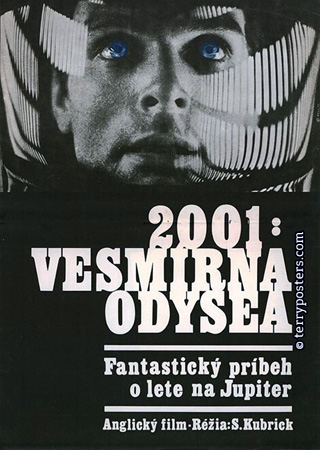 “2001: A Space Odyssey”
(2:29) + intermission.
Filmed in:
65mm, 24 frames per second.
Principal photography in: Super Panavision 70. Presented:
On the curved screen with 6-track Dolby Stereo, format 43.
Aspect ratio: 2,21;1. Country of origin: USA. Production year:
1968.
World Premiere: 02.04.1968 The Uptown Theatre, Washington, USA. “2001: A Space Odyssey”
(2:29) + intermission.
Filmed in:
65mm, 24 frames per second.
Principal photography in: Super Panavision 70. Presented:
On the curved screen with 6-track Dolby Stereo, format 43.
Aspect ratio: 2,21;1. Country of origin: USA. Production year:
1968.
World Premiere: 02.04.1968 The Uptown Theatre, Washington, USA.
Czeck premiere: 24.4.1970. Kino Mir 70
premiere: 27.11.1970.
Produced and directed by Stanley Kubrick. Cinematography by Geoffrey
Unsworth. Edited by Ray Lovejoy. Douglas Trumbull (special photographic
effects supervisor).
Keir Dullea (Dr. Dave Bowman), Gary Lockwood (Dr. Frank Poole), William
Sylvester (Dr. Heywood R. Floyd), Daniel Richter (Moon-Watcher), Douglas
Rain (HAL 9000 (voice))
Oscar: Special Visual Effects, Stanley Kubrick
Academy Award Nominated: Best Art Direction-Set Decoration, Best
Director, Best Writing, Story and Screenplay - Written Directly for the
Screen
Full credits
The CD
Soundtrack
A Roadshow
Odyssey
Restoring the
soundtrack
"2001" and the
curved screen
The Original Reserved Seat Engagements Of "2001: A Space Odyssey"
Christiane Kubrick's Website
Creating special effects for "2001"
Kubrick
Films and old Christiane Kubrick
web site hosted by Warner Brothers.
Warner Brothers' 7 year old "2001"
web site
10th Anniversary of Stanley Kubrick's passing
allmovie.com:
A mind-bending sci-fi symphony, Stanley Kubrick's landmark 1968
epic pushed the limits of narrative and special effects toward a
meditation on technology and humanity. Based on Arthur C.
Clarke's story The Sentinel, Kubrick and Clarke's screenplay is
structured in four movements. At the "Dawn of Man," a group of
hominids encounters a mysterious black monolith alien to their
surroundings. To the strains of Strauss's 1896 Also sprach
Zarathustra, a hominid invents the first weapon, using a bone to
kill prey. As the hominid tosses the bone in the air, Kubrick
cuts to a 21st century spacecraft hovering over the Earth,
skipping ahead millions of years in technological development.
U.S. scientist Dr. Heywood Floyd (William Sylvester) travels to
the moon to check out the discovery of a strange object on the
moon's surface: a black monolith. As the sun's rays strike the
stone, however, it emits a piercing, deafening sound that fills
the investigators' headphones and stops them in their path.
Cutting ahead 18 months, impassive astronauts David Bowman (Keir
Dullea) and Frank Poole (Gary Lockwood) head toward Jupiter on
the spaceship Discovery, their only company three hibernating
astronauts and the vocal, man-made HAL 9000 computer running the
entire ship. When the all-too-human HAL malfunctions, however,
he tries to murder the astronauts to cover his error, forcing
Bowman to defend himself the only way he can. Free of HAL, and
finally informed of the voyage's purpose by a recording from
Floyd, Bowman journeys to "Jupiter and Beyond the Infinite,"
through the psychedelic slit-scan star-gate to an 18th century
room, and the completion of the monolith's evolutionary mission.
|
Alien
|
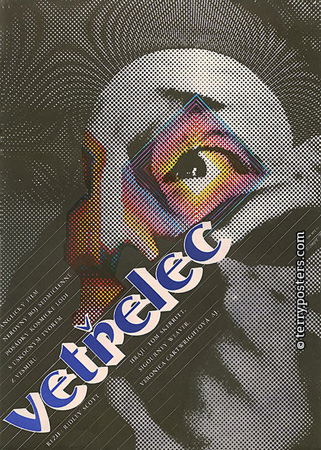 “Alien”
(1:57).
Filmed in:
35mm, 24 frames per second.
Principal photography in: Panavision. Presented:
On the curved screen with 6-track Dolby Stereo, format 42.
Aspect ratio: 2,21:1. Country of origin: USA. Production year:
1979.
World Premiere: 25.05.1979, USA. Czeck premiere:
1.1.1983. Kino Mir 70 premiere: 2.4.1983 “Alien”
(1:57).
Filmed in:
35mm, 24 frames per second.
Principal photography in: Panavision. Presented:
On the curved screen with 6-track Dolby Stereo, format 42.
Aspect ratio: 2,21:1. Country of origin: USA. Production year:
1979.
World Premiere: 25.05.1979, USA. Czeck premiere:
1.1.1983. Kino Mir 70 premiere: 2.4.1983
“Alien” 70mm
openings
30th anniversary screening
allmovie.com:
"In space, no one can hear you scream." A close encounter of the
third kind becomes a Jaws-style nightmare when an alien invades
a spacecraft in Ridley Scott's sci-fi horror classic. On the way
home from a mission for the Company, the Nostromo's crew is
woken up from hibernation by the ship's Mother computer to
answer a distress signal from a nearby planet. Capt. Dallas'
(Tom Skerritt) rescue team discovers a bizarre pod field, but
things get even stranger when a face-hugging creature bursts out
of a pod and attaches itself to Kane (John Hurt). Over the
objections of Ripley (Sigourney Weaver), science officer Ash
(Ian Holm) lets Kane back on the ship. The acid-blooded incubus
detaches itself from an apparently recovered Kane, but an alien
erupts from Kane's stomach and escapes. The alien starts
stalking the humans, pitting Dallas and his crew (and cat)
against a malevolent killing machine that also has a protector
in the nefarious Company.
|
The Untouchables
|
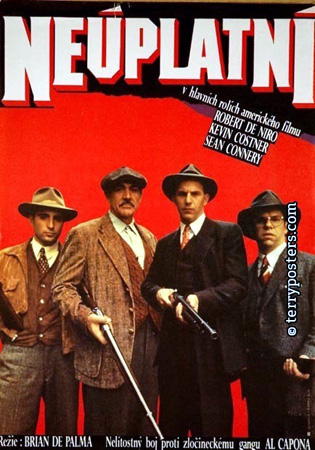 “The
Untouchables”
(1:59).
Filmed in:
35mm, 24 frames per second.
Principal photography in: Panavision. Presented:
On the curved screen with 6-track Dolby Stereo, format 43.
Aspect ratio: 2,35;1. Country of origin: USA. Production year:
1987.
World Premiere: 02.06.1987, USA. Czeck premiere:
6.3.1992.
Czeck premiere: 1.7.1990. Kino Mir 70 premiere:
9.10.1990 “The
Untouchables”
(1:59).
Filmed in:
35mm, 24 frames per second.
Principal photography in: Panavision. Presented:
On the curved screen with 6-track Dolby Stereo, format 43.
Aspect ratio: 2,35;1. Country of origin: USA. Production year:
1987.
World Premiere: 02.06.1987, USA. Czeck premiere:
6.3.1992.
Czeck premiere: 1.7.1990. Kino Mir 70 premiere:
9.10.1990
allmovie.com:
Like the TV series that shared the same title, "The Untouchables" was an account of the battle between gangster Al Capone
and lawman Eliot Ness, this time in the form of a feature film
boasting big stars, a big budget, and a script from respected
playwright David Mamet. Kevin Costner stars as Ness, a federal
agent who has come to Chicago during the Prohibition Era, when
corruption in the local police department is rampant. His
mission is to put crime lord Capone (Robert De Niro) out of
business, but Capone is so powerful and popular that Ness is not
taken seriously by the law or the press. One night, discouraged,
he meets a veteran patrolman, Jimmy Malone (Sean Connery), and
discovers that the acerbic Irishman is the one honest man he's
been seeking. Malone has soon helped Ness recruit a gunslinger
rookie, George Stone (Andy Garcia), and, joined by nebbish
accountant Oscar Wallace (Charles Martin Smith), the men
doggedly pursue Capone and his illegal interests. At first a
laughingstock, Ness soon has Capone outraged over his and
Malone's sometimes law-bending tactics, and the vain mobster
strikes back in vicious style. Ultimately, it is the most
unexpected and minor of crimes, tax evasion, which proves
Capone's undoing. All of the credits for The Untouchables
boasted big names, including music from Ennio Morricone and
costumes by Giorgio Armani. Director Brian De Palma continued
his tradition of including a homage to past masters of the
cinema with a taut stairway shoot-out reminiscent of a similar
sequence in Sergei Eisenstein's Battleship Potemkin (1925).
|
Sunday, 5. April 2009
|
"The Last Valley"
|
  "The
Last Valley" (2:06) (+ intermission).
Filmed
in:
65mm, 5 perforations, 24 frames per second.
Principal photography in:
Todd-AO.
Presented:
On the curved screen in a vintage Todd-AO 70mm print
with 6-track magnetic stereo.
Aspect ratio: 2,21:1. Country of origin: USA. Production
year:
1970
World Premiere: 21.01.1971,
Rivoli, New York.
Czeck
premiere, Kino Mir 70: 05.04.2009 "The
Last Valley" (2:06) (+ intermission).
Filmed
in:
65mm, 5 perforations, 24 frames per second.
Principal photography in:
Todd-AO.
Presented:
On the curved screen in a vintage Todd-AO 70mm print
with 6-track magnetic stereo.
Aspect ratio: 2,21:1. Country of origin: USA. Production
year:
1970
World Premiere: 21.01.1971,
Rivoli, New York.
Czeck
premiere, Kino Mir 70: 05.04.2009
Directed and produced by James Clavell. Written by James Clavell. Music by
John Barry. Cinematography by Norman Warwick & John Wilcox. Edited by John
Bloom
Michael Caine (The Captain), Omar Sharif (Vogel), Florinda Bolkan (Erica),
Nigel Davenport (Gruber), Per Oscarsson (Father Sebastian)
Original version.
70mm print thanks to
National
Media
Museum
and the
Bradford International Film Festival
The film opens with an old style UK ‘AA’ Certificate followed by silent
‘Cinerama Releasing’ and ‘ABC’ trademarks. The Intermission title is 39 feet
long at the end of reel 5. Part 6 has a 3 min play in to the second half.
There is no play in to the first half.
Very short end credits. Last credit is a silent ‘Soundtrack Available…’ etc.
70mm print number 11 / 8 reels.
Taking a Mini View in a Maxi
Way
Todd-AO films
allmovie.com: Noted novelist and sometime film director James Clavell, wrote, directed,
and produced this adaptation of J.B. Pick's novel, set during the Thirty
Years' War of 1618-1648. During the chaotic confrontations and shifting
alliances of the war, a hidden valley protected from the outside world
becomes an oasis of peace. Vogel (Omar Sharif), a one-time school teacher
now on the run, travels into the peaceful valley. Following Vogel a short
time later is a rag-tag and exhausted army, led by The Captain (Michael
Caine). Utilizing Vogel as a mediator, the Captain arranges a truce with the
valley population -- pledging to protect the people of the valley from
invasion in return for food and shelter during the cold winter months. At
the end of the season, the army leaves to fight another battle, Vogel is
asked to depart from the hidden valley, and the valley and its population
continues on and endures.
|
Terminator 2 - Judgement Day
|
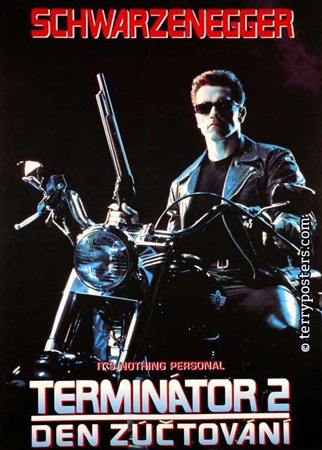 “Terminato
2 - Judgement Day”
(2:17).
Filmed in:
35mm, 24 frames per second.
Principal photography in: Panavision Super 35. Presented:
On the curved screen with 6-track Dolby Stereo, format 43.
Aspect ratio: 2,21;1. Country of origin: USA. Production year:
1991.
World Premiere: 01.07.1991, USA. Czeck premiere:
6.3.1992. Kino Mir 70 premiere: 17.4.1992 “Terminato
2 - Judgement Day”
(2:17).
Filmed in:
35mm, 24 frames per second.
Principal photography in: Panavision Super 35. Presented:
On the curved screen with 6-track Dolby Stereo, format 43.
Aspect ratio: 2,21;1. Country of origin: USA. Production year:
1991.
World Premiere: 01.07.1991, USA. Czeck premiere:
6.3.1992. Kino Mir 70 premiere: 17.4.1992
allmovie.com:
A sequel to the low-budget sci-fi action thriller that made him
and star Arnold Schwarzenegger A-list Hollywood names,
writer/director James Cameron upped the ante with this follow-up
by employing a more sweeping storyline and cutting-edge special
effects. Linda Hamilton returns as Sarah Connor, now a single
mother to rebellious teen John Connor (Edward Furlong), during
the late nineties. Having been informed by a time-traveling
soldier in the first film that John will one day grow up to
become humanity's savior from a computer-controlled Armageddon,
Sarah has responded by becoming a muscle-bound she-warrior bent
on educating John in survival tactics and battle strategies. Her
ranting about humankind's future has landed Sarah in an insane
asylum and John in the foster care system. The rebellious John
has responded to his situation by getting into scrapes with the
law. When a new and improved Terminator android called the
T-1000 (Robert Patrick) arrives from the future to eliminate
John, an older model T-800 (Schwarzenegger) is sent to protect
the boy. The T-1000, however, has the ability to morph itself
into any shape it desires, allowing it chameleon-like powers and
near indestructibility. The T-800 saves John's life and helps
break Sarah out of the institution. Staying only one step ahead
of the dogged T-1000, Sarah leads her son and the T-800 to the
headquarters of Cyberdyne Systems, the company that will invent
a robotic intelligence that will eventually take over the world.
There, they attempt to convince inventor Miles Dyson (Joe
Morton) to help them stop the future from ever occurring by
destroying his work. Dyson sacrifices himself in an explosion to
save the world, leading to a final showdown between the two
Terminators at a steel foundry.
|
"Those Magnificient Men in Their Flying Machines"
|
  “Those
Magnificient Men in Their Flying Machines, or How I flew from
London to Paris, in 25 hours and 11 minutes”
(2:18) + intermission.
Filmed in:
65mm, 24 frames per second.
Principal photography in: Todd-AO. Presented on:
The curved screen in Todd-AO with 6-track DTS Stereo.
Aspect ratio: 2,21;1. Country of origin: USA. Production year:
1965.
World Premiere: 03.06.1965 Astoria, London, England. Czeck
premiere: 8.9.1967. Kino Mir 70 premiere:
23.5.1969 “Those
Magnificient Men in Their Flying Machines, or How I flew from
London to Paris, in 25 hours and 11 minutes”
(2:18) + intermission.
Filmed in:
65mm, 24 frames per second.
Principal photography in: Todd-AO. Presented on:
The curved screen in Todd-AO with 6-track DTS Stereo.
Aspect ratio: 2,21;1. Country of origin: USA. Production year:
1965.
World Premiere: 03.06.1965 Astoria, London, England. Czeck
premiere: 8.9.1967. Kino Mir 70 premiere:
23.5.1969
What is Todd-AO?
40th
anniversary screening
|
"2001: A Space Odyssey"
|
 “2001: A Space Odyssey”
(2:29) + intermission.
Filmed in:
65mm, 24 frames per second.
Principal photography in: Super Panavision 70. Presented:
On the curved screen with 6-track Dolby Stereo, format 43.
Aspect ratio: 2,21;1. Country of origin: USA. Production year:
1968.
World Premiere: 02.04.1968 The Uptown Theatre, Washington, USA. “2001: A Space Odyssey”
(2:29) + intermission.
Filmed in:
65mm, 24 frames per second.
Principal photography in: Super Panavision 70. Presented:
On the curved screen with 6-track Dolby Stereo, format 43.
Aspect ratio: 2,21;1. Country of origin: USA. Production year:
1968.
World Premiere: 02.04.1968 The Uptown Theatre, Washington, USA.
Produced and directed by Stanley Kubrick. Cinematography by Geoffrey
Unsworth. Edited by Ray Lovejoy. Douglas Trumbull (special photographic
effects supervisor).
Keir Dullea (Dr. Dave Bowman), Gary Lockwood (Dr. Frank Poole), William
Sylvester (Dr. Heywood R. Floyd), Daniel Richter (Moon-Watcher), Douglas
Rain (HAL 9000 (voice))
Oscar: Special Visual Effects, Stanley Kubrick
Academy Award Nominated: Best Art Direction-Set Decoration, Best
Director, Best Writing, Story and Screenplay - Written Directly for the
Screen
10th Anniversary of Stanley Kubrick's passing
|
|
|
|
|
More
in 70mm reading:
Krnov 2008 festival report
First 70mm Seminar
Second 70mm Seminar
Third 70mm Seminar
4th 70mm Seminar - Gallery
Internet link:
Kino Mir 70
Namesti Miru 14
794 01 Krnov
The Czech Republic
Telephone: +420 554 615 050
Head of the Kino Mir 70: Pavel Tomešek
Official Festival Page
Filmvorfuehrer.de
www.krnov.cz
ACFC
YouTube
clip
Czeck posters from
terryhoponozky.cz
|
How to get to Krnov
| |
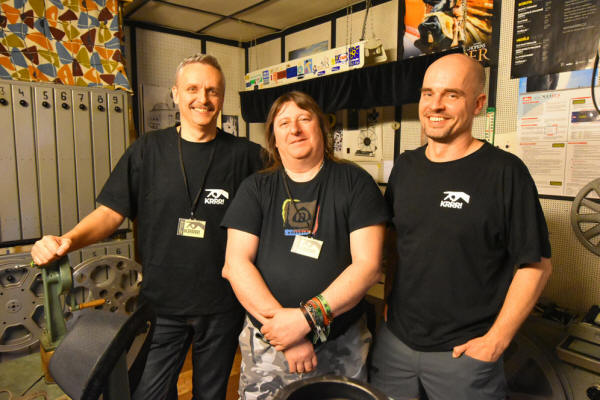 Projection
and technical staff are ready to show 70mm films. Projection
and technical staff are ready to show 70mm films.
By car:
GPS: 50.086352, 17.699144
By train:
The train station is called Krnov - Hlavní nádraží (Krnov - Main
Station), from the staiton it is 1,6 km to the cinema. You can take
Revoluční street, when you pass Albert hypermarket you turn right, then
cross the bridge and on your right you can see the movie theatre "Kino
Mír".
By bus:
Bus station is next to the Albert hypermarket so you cross the bridge
and on your right you can see the movie theatre "Kino Mír".
By plane:
You get to the Prague Airport (PRG) and then you can go by train from Prague to Krnov-Cvilin.
You get to the Vienna/Wien Airport (Austria) and then you can go by train from
Vienna Airport to Krnov-Cvilin.
|
|
Accommodation
| |
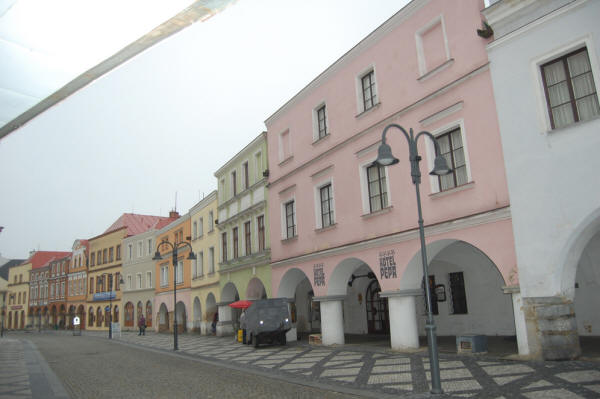 For
more information, please, contact Jakub Klíma For
more information, please, contact Jakub Klíma
Hotel Pepa ****
Zámecké náměstí 7
794 01 Krnov
tel.: 554 611 005, 554 610 806
Hotel Steiger ****
tel: +420 554 610 222
mobil: +420 603 272 505
Hotel Cvilín ****
Vyhlídka Krnov s.r.o.
Výletní 7,
794 01 Krnov
tel.: 554 625 275, 554 625 255, 777 559 019
Penzion Koliba
Švabinského 7,
794 01 Krnov
tel.: 554 612 803
Pension Eso
Bezručova 29
794 01 Krnov
tel./fax: 554 618 095
Penzion Šelenburk
V Zálesí 31
794 01 Krnov
tel.: 554 614 900
|
|
Kino Mir 70
| |
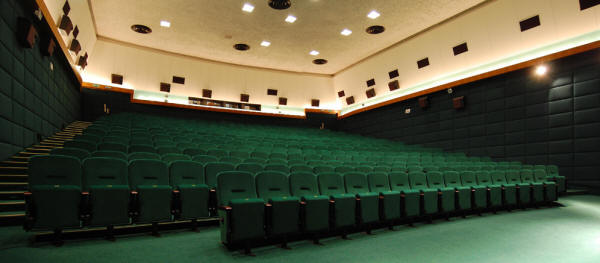 70mm Screen size: 14 x 7m, slightly curved 70mm Screen size: 14 x 7m, slightly curved
First 70mm film: "Those Magnificent Men in Their Flying Machines" -
23.05.1969
Sound: Dolby Stereo EX, DTS
Speakers: K.C.S. (Kelonik Cinema Sound) S- 3000, 4 OHMS, 600 WATTS (3 behind
screen) + K.C.S subwoofers: C-218-A, 4 OHMS, 1200 WATTS + Effect channel: 16
speakers, Left wall: 4 speakers, right wall 4 speakers, rear wall: 8
speakers: SR-15, 8 OHMS, 200 WATTS each.
Processor: Model CP65 + DA20 + Model SA10 – EX
DTS: XD10 - CinemaMediaPlayer
Seats: 349
There is a reconstruction of audience planned in the end of August 2007. The
old seats will be replaced by new, more comfortable seats. We will keep you
informed. The capacity will be reduced to 320 seats.
Projectors: 2 x UM 70/35XB, 2 x Meo5XB + Meo II. X (16 mm ) optical analogue
sound record, 6 channel magnetic record, 4 channel magnetic. record, Dolby
Digital EX, DTS(35mm) DTS for 70mm screening is coming in September 2007
City of Krnov: 26 000 inhabitants
|
|
Credits
|
|
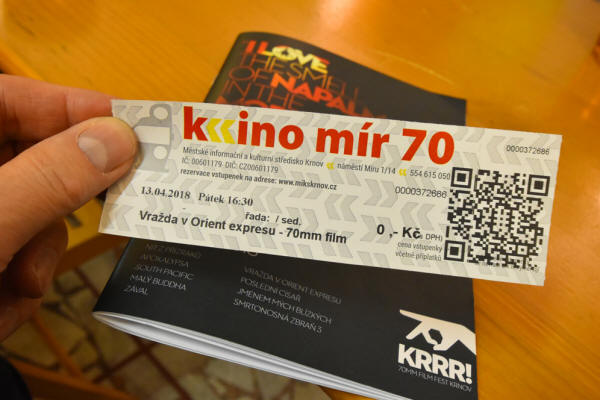 Your
tickets are ready for the beautiful Kino Mir 70. Your
tickets are ready for the beautiful Kino Mir 70.
The organisers wish to thank the following individuals for their help:
Jaromír Blažejovský, PhD, from Masaryk University who was again asked
about introducing each title.
Many thanks go to Pavel Tomešek, the head of the theather Mir 70 in
Krnov, officals of culture department of Krnov (MIKS) for their
neverending work.
Special thanks goes to Jean Pierre Gutzeit, Germany.
Many thanks to Herbert Born, Germany, Thomas Hauerslev, Denmark.
Francois Carrin, France and Maciej Gill, Poland and many others for
their endeavour work.
|
|
| |
|
Go: back
- top -
back issues
- news index
Updated
22-01-25 |
|
|
 4th Seminar of 70mm film in Krnov
3 - 5 . April 2009.
4th Seminar of 70mm film in Krnov
3 - 5 . April 2009. Projection
and technical staff are ready to show 70mm films.
Projection
and technical staff are ready to show 70mm films.  For
more information, please, contact Jakub Klíma
For
more information, please, contact Jakub Klíma 70mm Screen size: 14 x 7m, slightly curved
70mm Screen size: 14 x 7m, slightly curved Your
tickets are ready for the beautiful Kino Mir 70.
Your
tickets are ready for the beautiful Kino Mir 70. 

 “Signale
- Ein Weltraumabenteuer” (1:28). Filmed in: 70mm, 5
perforations, 24 frames per second. Principal photography in:
“Signale
- Ein Weltraumabenteuer” (1:28). Filmed in: 70mm, 5
perforations, 24 frames per second. Principal photography in:


 “Those
Magnificient Men in Their Flying Machines, or How I flew from
London to Paris, in 25 hours and 11 minutes”
(2:18) + intermission.
“Those
Magnificient Men in Their Flying Machines, or How I flew from
London to Paris, in 25 hours and 11 minutes”
(2:18) + intermission.

 "Goya
– oder der arge Weg der Erkenntnis" / "Goya – or the hard way to enlightment"
"Goya
– oder der arge Weg der Erkenntnis" / "Goya – or the hard way to enlightment"
 15.00 – 17.00 "Faubourg 36"
15.00 – 17.00 "Faubourg 36"
 “2001: A Space Odyssey”
(2:29) + intermission.
“2001: A Space Odyssey”
(2:29) + intermission.
 “Alien”
(1:57).
“Alien”
(1:57).
 “The
Untouchables”
(1:59).
“The
Untouchables”
(1:59).

 “Terminato
2 - Judgement Day”
(2:17).
“Terminato
2 - Judgement Day”
(2:17).